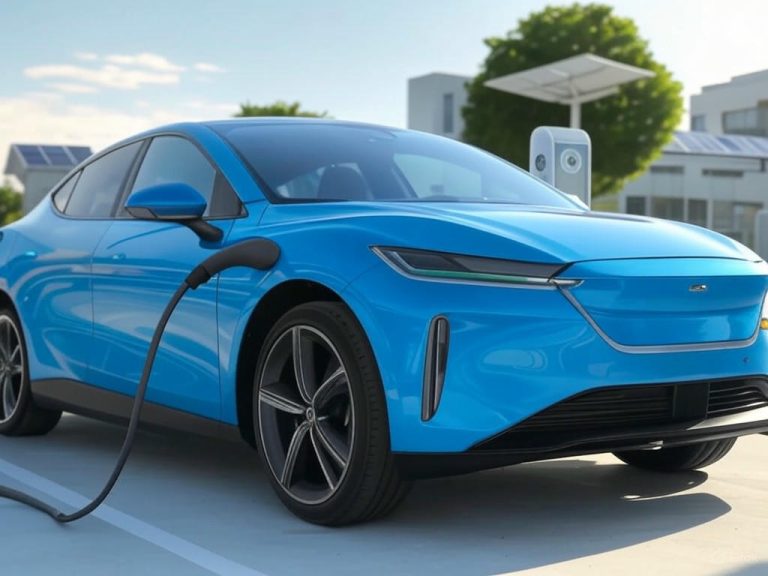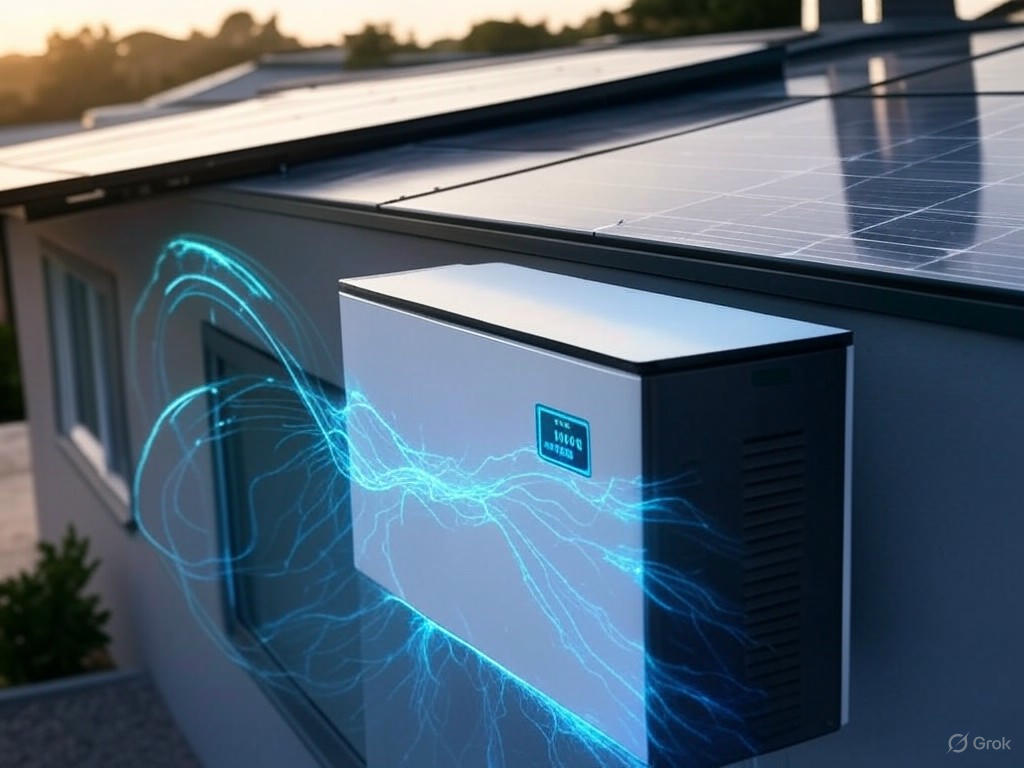
Home Solar Battery Guide 2025: Expert Picks & Smart Storage Tips
- Introduction: Understanding Home Solar Battery Storage in 2025
- Introduction: Understanding Home Solar Battery Storage in 2025
- Energy Independence: Beyond Just Solar Panels
- Financial Considerations: Costs, Incentives, and Payback
- Backup Power: Reliable Energy When You Need It Most
- Prerequisites: Key Technical Concepts and Requirements for Solar Battery Systems
- Prerequisites: Key Technical Concepts and Requirements for Solar Battery Systems
- Solar Panel Integration and Inverter Compatibility
- Battery Chemistry: Why Lithium-Ion Leads the Market
- Understanding Capacity Metrics: Usable vs. Total Capacity
- Depth of Discharge (DoD) and Peak Power Output
- Warranty Terms: What to Expect and Key Considerations
- Local Energy Rates and Net Metering: Impact on Battery Value
- Preparation: Assessing Your Household Energy Needs and Installation Considerations
- Preparation: Assessing Your Household Energy Needs and Installation Considerations
- Measuring Household Energy Consumption
- Installation Site Evaluation
- Budgeting: Costs, Incentives, and Financing
- Practical Takeaway
- Step-by-Step Guide to Choosing and Installing a Home Solar Battery
- Step-by-Step Guide to Choosing and Installing a Home Solar Battery
- Evaluating Top Battery Models: Capacity, Power, Warranty, and Cost
- Selecting the Right Size and Features for Your Home
- Installation Phases: What to Expect
- Real-World Installation Experiences and Caveats
- Summary
- Technical Analysis and Comparative Benchmarking of Leading Solar Batteries
- Technical Analysis and Comparative Benchmarking of Leading Solar Batteries
- Usable Capacity and Depth of Discharge
- Peak Power and Efficiency
- Lifecycle Degradation and Warranty Coverage
- Innovations: Virtual Power Plants and Safety Features
- Limitations and Trade-Offs: What Real Users Report
- Summary
- Troubleshooting and Maintenance: Common Issues and How to Address Them
- Troubleshooting and Maintenance: Common Issues and How to Address Them
- Diagnosing Frequent Solar Battery Problems
- Preventative Maintenance and Safety Precautions
- Manufacturer Support and Firmware Updates
- Final Takeaways
- Advanced Optimizations and Future-Proofing Your Solar Storage Investment
- Advanced Optimizations and Future-Proofing Your Solar Storage Investment
- Leveraging Time-of-Use (TOU) Energy Plans for Cost Savings
- Virtual Power Plants (VPPs) and Scalable Battery Configurations
- Emerging Technologies and Anticipated Pricing Trends
- Smart Home Integration and Monitoring Tools for Efficiency
- Key Takeaways for Your Solar Storage Investment
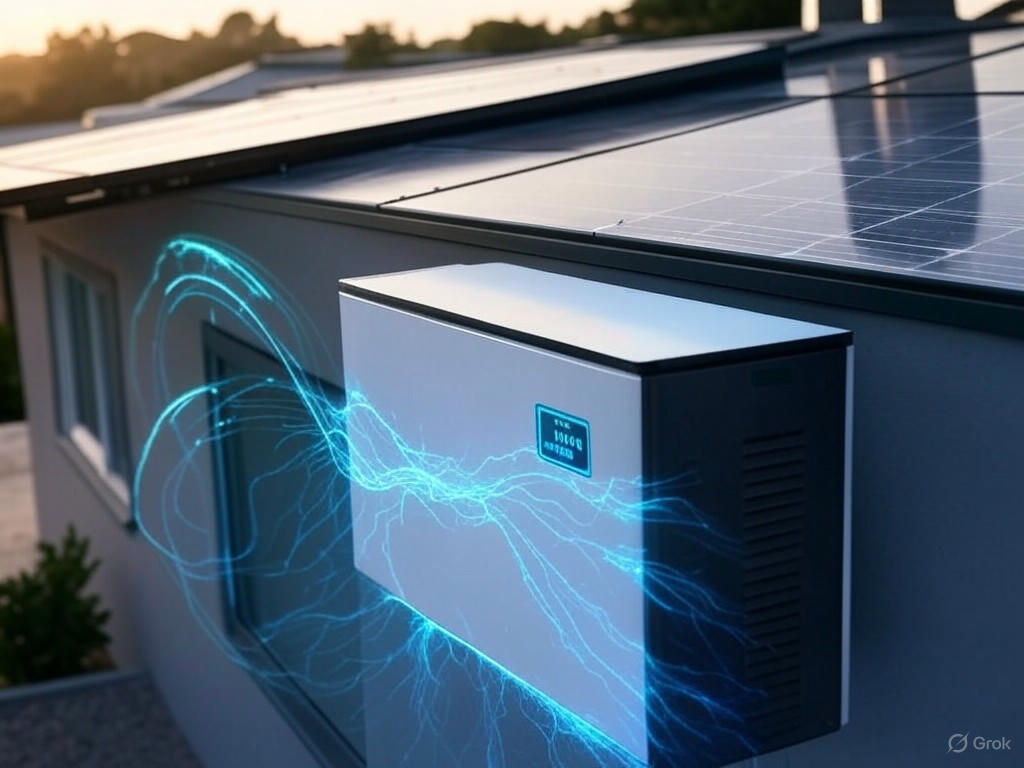
Introduction: Understanding Home Solar Battery Storage in 2025

Introduction: Understanding Home Solar Battery Storage in 2025
In 2025, solar batteries have evolved from niche products to essential components of modern home energy systems. For homeowners, they unlock true energy independence, enhanced cost savings, and reliable backup power. Unlike solar panels alone—which typically shut down during grid outages due to safety protocols—solar-plus-storage systems with islanding capability allow your home to remain powered when the grid fails. This capability fundamentally changes energy resilience and security for homeowners.
Energy Independence: Beyond Just Solar Panels
Relying solely on solar panels without storage limits your control over energy use. Solar production peaks during daylight hours, often generating more electricity than you consume in real time. Traditionally, this surplus energy is exported back to the grid, but net metering policies may offer reduced credit rates, diminishing financial returns.
A quality solar battery stores this excess energy for later use, particularly during evenings or cloudy days. By shifting from immediate export to self-consumption, batteries increase your home’s energy autonomy, reducing reliance on the grid and providing protection against fluctuating electricity rates.
In regions with time-of-use (TOU) rates or demand charges, batteries can deliver significant savings by shifting consumption away from peak pricing periods. However, the financial benefit depends heavily on your utility’s specific rate design. Where flat rates and full net metering prevail, cost savings may be modest, with backup power as the primary value.
Financial Considerations: Costs, Incentives, and Payback
Solar battery systems remain a substantial investment, with installed costs typically ranging from $6,000 to $23,000. Pricing depends on battery capacity, chemistry, installation complexity, and brand. Most residential batteries offer usable capacities between 8 and 12 kWh, with costs around $400 to $750 per kilowatt-hour.
Fortunately, 2025 presents increasingly favorable economics. The federal Residential Clean Energy Credit offers a 30% tax credit on qualified solar-plus-storage installations, cutting upfront costs by nearly one-third. Additionally, some states add rebates—for example, California’s Self-Generation Incentive Program (SGIP) can provide up to $1,000 per kWh, substantially lowering net expenses.
Internationally, Australia’s government initiatives reduce upfront battery costs by about 30%, enabling combined solar and battery payback periods as short as 5.6 years—dramatically improved compared to earlier years when paybacks often exceeded a decade.
It remains essential to analyze your local utility rates, energy consumption patterns, and incentives. Batteries are not universally money-saving; balancing battery size, cost, and expected savings is critical to avoid overpaying for unused capacity or outdated technology.
Backup Power: Reliable Energy When You Need It Most
The practical advantage of solar batteries becomes evident during power outages. Standard grid-tied solar systems shut off automatically when the grid goes down, even if the sun is shining, due to safety protocols protecting utility workers.
With the appropriate inverter and battery setup, solar-plus-storage systems can island from the grid, powering critical household loads continuously. Lithium-ion batteries—especially lithium iron phosphate (LFP) chemistry—are popular in 2025 for their safety, longevity, and thermal stability, typically lasting 15 to 20 years and enduring thousands of full charge cycles.
Backup duration depends on your household’s energy demand and battery capacity. While traditional generators may run longer, solar batteries offer cleaner, quieter, and maintenance-free backup. Moreover, during extended outages, daytime solar generation can recharge the battery, extending backup times significantly.
Given the increasing frequency of extreme weather events and unpredictable grid stability, many homeowners in 2025 consider battery backup a practical necessity rather than a luxury, providing peace of mind and energy security.
This guide is designed to help you cut through marketing hype and understand the essential specifications, real-world performance, and practical factors influencing solar battery selection. You’ll learn how to evaluate capacity, depth of discharge, warranty coverage, and system integration, balancing upfront costs with long-term value. The goal is to empower you to make an informed, evidence-based decision tailored to your energy goals, lifestyle, and budget in 2025.
| Aspect | Details |
|---|---|
| Energy Independence | Solar batteries store excess solar energy for use during evenings or cloudy days, increasing energy autonomy and reducing grid reliance. Important under TOU rates for cost savings. |
| Financial Considerations | Costs range from $6,000 to $23,000; 8-12 kWh capacity; $400-$750 per kWh; 30% federal tax credit; state rebates (e.g., California SGIP); payback varies by region and utility rates. |
| Backup Power | Solar-plus-storage systems with islanding capability provide power during outages. Lithium iron phosphate (LFP) batteries preferred for safety and longevity (15-20 years). Backup duration depends on battery size and household demand. |
| Battery Chemistry | Lithium-ion, especially lithium iron phosphate (LFP), known for safety, thermal stability, and long cycle life. |
| Incentives | Federal Residential Clean Energy Credit (30% tax credit); state rebates like California’s SGIP; Australia’s initiatives reducing upfront costs by ~30%. |
| Payback Periods | As short as 5.6 years in Australia with incentives; can exceed a decade without. |
| Importance of Local Analysis | Utility rates, consumption patterns, and incentives critical to evaluate to avoid overpaying or underutilizing battery capacity. |
Prerequisites: Key Technical Concepts and Requirements for Solar Battery Systems
Prerequisites: Key Technical Concepts and Requirements for Solar Battery Systems
Before investing in a solar battery system, it’s essential to understand the technical fundamentals that govern how these systems operate. Solar batteries do more than simply store energy—they depend on a precise integration of components, battery chemistry, and local policies that together determine performance, reliability, and financial value. Drawing on extensive experience testing various setups, this section highlights the core technical concepts every homeowner should know in 2025.
Solar Panel Integration and Inverter Compatibility
A home solar battery stores the excess electricity your solar panels generate during peak sunlight hours. Since solar panels produce direct current (DC) electricity, an inverter is necessary to convert it into alternating current (AC) for use in your home. Your battery system must be compatible with your solar inverter or include its own inverter, depending on the coupling method.
- AC-coupled batteries connect on the AC side of the system. They are typically easier to retrofit into existing solar installations without major rewiring.
- DC-coupled batteries integrate directly on the DC side, often offering higher efficiency by reducing conversion losses. However, they tend to be more complex and costly to install with pre-existing panels.
For example, the Tesla Powerwall 3 is designed to work seamlessly with both new and existing solar arrays, supporting a broad range of inverter configurations. On the other hand, modular systems like Enphase IQ Batteries provide flexible expansion options but require compatible inverter technology to operate effectively.
Additionally, your home’s electrical system must accommodate the battery’s peak power output—the maximum continuous power the battery can safely deliver. Selecting a battery that meets or exceeds your household’s peak load demands is critical to avoid safety cutoffs and potential damage to components.
Battery Chemistry: Why Lithium-Ion Leads the Market
In 2025, lithium-ion technology remains the dominant choice for residential solar batteries due to its superior energy density, efficiency, lifespan, and cost-effectiveness. Within this category, lithium iron phosphate (LFP) batteries are increasingly popular for their enhanced thermal stability and longer cycle life compared to traditional lithium-ion variants.
Key advantages of lithium-ion batteries include:
- Higher Depth of Discharge (DoD): Many lithium-ion batteries support up to 100% DoD, allowing nearly full use of stored energy without compromising battery health.
- Long Lifespan: Typical lithium-ion battery lifespans range from 10 to 15 years, with warranties often guaranteeing at least 70% capacity retention after 10 years.
- High Efficiency: Round-trip efficiencies exceed 90%, minimizing energy losses during charging and discharging.
While lead-acid batteries are still available, they are less practical for modern home storage due to lower efficiency, bulkier form factors, shorter lifespan, and limited DoD (typically around 50%).
Understanding Capacity Metrics: Usable vs. Total Capacity
Capacity is often misunderstood when evaluating solar batteries. Manufacturers usually advertise the battery’s total or maximum capacity in kilowatt-hours (kWh), but the usable capacity—the actual amount of energy available for use—is the more important figure.
- Total capacity refers to the full energy the battery cells can theoretically store.
- Usable capacity accounts for operational limits set to protect battery longevity, such as DoD restrictions.
For example, a battery with a total capacity of 13.5 kWh may have a usable capacity of around 11 kWh if it limits discharge to 80% to extend lifespan. Understanding usable capacity helps you size your system accurately to match your daily energy consumption and backup requirements. Overestimating usable capacity can lead to insufficient backup duration and unrealized savings.
Depth of Discharge (DoD) and Peak Power Output
Depth of Discharge (DoD) indicates how much of the battery’s total capacity can be safely used without accelerating degradation.
- Most modern lithium-ion batteries in home storage systems support DoDs between 90% and 100%.
- Lead-acid batteries generally have a lower safe DoD, around 50%, limiting usable energy.
Peak power output, measured in kilowatts (kW), defines the maximum power the battery can supply continuously. This determines whether the battery can handle high-demand periods, such as running multiple appliances or an HVAC system simultaneously during an outage.
For instance, the Franklin aPower2 battery delivers a continuous output of 10 kW, suitable for larger homes or critical load backup. Conversely, smaller units like the Enphase IQ Battery 5P provide around 5 kW, adequate for modest backup needs.
Warranty Terms: What to Expect and Key Considerations
Warranties provide important protection for your investment. Most residential solar batteries come with a 10-year warranty, guaranteeing the battery retains at least 70% of its original capacity at the end of that period. Some newer market entrants, such as Solar Insure, offer extended warranties up to 30 years, although these are still rare and often tied to specific installation conditions or insurance products.
Important warranty details to review include:
- Cycle or throughput limits: Some warranties expire after the battery has delivered a certain total energy throughput, regardless of time.
- Performance guarantees: Minimum capacity retention (generally 70%) is commonly specified at warranty expiration.
- Transferability: Transferable warranties can enhance your home’s resale value.
Always read warranty fine print carefully. Exclusions for damage due to weather, improper installation, or unauthorized service can void coverage.
Local Energy Rates and Net Metering: Impact on Battery Value
The economic benefits of solar batteries depend heavily on local utility rate structures and policies like net metering.
- Net metering credits homeowners for excess solar power sent back to the grid, often at retail rates.
- However, many states are reducing net metering benefits or lowering credit rates, which can reduce the financial returns of exporting solar energy.
In regions where net metering credits decline, battery storage becomes more valuable by enabling greater self-consumption—storing daytime solar energy for use during peak-rate periods.
Time-of-use (TOU) rate structures, where electricity prices vary by hour, further incentivize batteries. By discharging stored energy during costly peak hours, homeowners can significantly reduce their electricity bills.
Ultimately, the value of a solar battery system relies as much on understanding your local policies and energy pricing as on the technical specifications of the battery itself.
In summary, selecting the right solar battery system in 2025 requires a clear understanding of how your solar panels and inverter interact with the battery, the advantages of lithium-ion chemistry (especially LFP), accurate sizing based on usable capacity and DoD, careful review of warranty terms, and an informed evaluation of local net metering and utility rate structures. This holistic approach ensures your solar storage investment delivers reliable performance, financial savings, and energy independence tailored to your home’s needs.
| Concept | Description | Examples / Details |
|---|---|---|
| Solar Panel Integration and Inverter Compatibility | Integration method between solar panels and battery system; affects efficiency and installation complexity. | AC-coupled: connects on AC side, easier retrofit. DC-coupled: connects on DC side, higher efficiency, more complex. Examples: Tesla Powerwall 3 (compatible with many inverters), Enphase IQ Batteries (modular, inverter-dependent). |
| Battery Chemistry | Type of battery cells used, influencing performance and longevity. | Lithium-ion (LFP): dominant in 2025, high energy density, efficiency, lifespan, and thermal stability. Lead-acid: lower efficiency, bulkier, shorter lifespan, ~50% DoD. |
| Capacity Metrics | Difference between total and usable energy storage. | Total Capacity: full theoretical storage. Usable Capacity: energy available after DoD limits. Example: 13.5 kWh total → ~11 kWh usable at 80% DoD. |
| Depth of Discharge (DoD) and Peak Power Output | DoD indicates safe usable capacity percentage; peak power output is max continuous power delivery. | DoD: Lithium-ion 90-100%, Lead-acid ~50%. Peak Power: Franklin aPower2 = 10 kW (large homes), Enphase IQ Battery 5P = 5 kW (modest backup). |
| Warranty Terms | Coverage details protecting battery performance and investment. | Typical: 10 years, 70% capacity retention. Extended: up to 30 years (rare). Includes cycle/throughput limits, performance guarantees, transferability considerations. |
| Local Energy Rates and Net Metering | Utility rate structures and policies influencing battery financial value. | Net Metering: credits for solar export, declining in some states. Time-of-Use Rates: incentivize battery use during peak hours. Storage increases self-consumption and savings where credits decline. |
Preparation: Assessing Your Household Energy Needs and Installation Considerations
Preparation: Assessing Your Household Energy Needs and Installation Considerations
Properly sizing a solar battery begins with a detailed understanding of your household’s energy consumption patterns. The average U.S. home uses about 855 kWh monthly, resulting in roughly a $136 electricity bill. However, consumption varies widely by region—for example, homes in Louisiana typically use over 14,000 kWh annually, while California homes average closer to 6,300 kWh. Factors such as your local climate, lifestyle, and HVAC usage heavily influence these figures.
Measuring Household Energy Consumption
To size your battery accurately, analyze your actual electricity usage data over time. While utility bills provide monthly kWh totals, access to daily or hourly smart meter data offers better granularity, enabling you to identify peak demand periods. This detail is especially important if your utility employs time-of-use (TOU) rates or peak demand charges, common in many markets in 2025.
Follow these steps to gather relevant data:
- Collect 12 months of utility bills to account for seasonal variation.
- Identify your peak load times, which often occur in mornings and evenings but can vary.
- Set clear backup power goals: Decide whether you want your battery to power essential loads during outages for a few hours or maintain full home operation for longer durations.
For example, a Tesla Powerwall 3 with 13.5 kWh capacity can power a typical home for 8–12 hours at full load or extend beyond 24 hours under partial load. If your goal is full-day backup, you might need around 30 kWh of usable battery capacity, but this comes with higher costs and space requirements. Alternatively, focusing on critical circuits like lighting, refrigeration, and communications can reduce your battery size needs to 5–10 kWh, which is more cost-effective and space-friendly.
Installation Site Evaluation
Evaluating your installation site is critical to ensure safety, functionality, and system longevity.
-
Available Space: Residential lithium-ion batteries generally require a dedicated, well-ventilated area indoors or outdoors. A typical 13.5 kWh unit measures approximately 26″ tall × 16″ wide × 6″ deep. Verify you have sufficient wall or floor space that meets these dimensions.
-
Safety Clearances: Updated 2024 installation standards mandate clearances around battery units for proper heat dissipation and emergency access. Always consult local building codes and installer recommendations to comply with these requirements.
-
Electrical Infrastructure: Your home’s electrical panel must support battery integration. Older panels may need upgrading to handle the additional load safely. Also, determine whether your battery system will be AC-coupled or DC-coupled, as this impacts wiring complexity and compatibility with your existing solar array.
-
Monitoring and Control: Modern batteries include monitoring apps or portals that track state of charge, usage patterns, and battery health. Confirm that your Wi-Fi and cellular connectivity at the installation location are reliable to support remote monitoring and firmware updates.
Budgeting: Costs, Incentives, and Financing
Upfront costs remain a significant consideration but have become more manageable in 2025 due to incentives and market competition. Typical price ranges are:
-
Battery system costs: Installed home solar battery systems range between $6,000 and $18,000, depending on capacity and brand. For instance, a fully installed 13.5 kWh lithium-ion battery averages about $13,500 after applying the 30% Residential Clean Energy Credit.
-
Installation fees: These vary widely based on location and complexity. Panel upgrades and electrical work can add several thousand dollars to the total cost.
-
Federal tax incentives: The Residential Clean Energy Credit currently offers a 30% tax credit on qualified battery installations through 2032, significantly reducing net costs.
-
State and local incentives: Additional rebates and financing programs may be available depending on your state or municipality. California’s Self-Generation Incentive Program (SGIP), for example, can provide rebates up to $1,000 per kWh of battery capacity, while Property Assessed Clean Energy (PACE) financing offers low-interest loans repayable through property tax assessments.
-
Financing options: Solar loans with $0 down and flexible terms from 8 to 20 years are common. Many lenders structure payments to accommodate the timing of tax credits, easing initial financial burdens. Some offer combo loans for solar and battery systems or reamortization options tailored to clean energy investments.
Practical Takeaway
Before investing in a solar battery system, obtain a comprehensive energy audit and consult with certified installers to evaluate your home’s electrical compatibility and available space. Use your historical energy consumption data to establish realistic backup duration goals that align with your budget and lifestyle.
Experience shows that undersized batteries often lead to frequent depletion and user frustration, while oversized systems can result in unnecessary expenses and underutilized capacity. A balanced approach—targeting essential loads and leveraging TOU rate structures—optimizes both comfort and cost-effectiveness.
Bottom line: Accurate measurement of your household energy profile, thorough site evaluation, and informed budgeting form the foundation of a successful home solar battery installation in 2025. Skipping these preparatory steps risks overpaying or ending up with a system that fails to meet your needs.
| Category | Details |
|---|---|
| Average U.S. Home Energy Use | 855 kWh/month, ~$136 electricity bill |
| Regional Consumption Examples | Louisiana: >14,000 kWh/year; California: ~6,300 kWh/year |
| Battery Capacity Example | Tesla Powerwall 3: 13.5 kWh, powers home 8–12 hrs full load, >24 hrs partial load |
| Backup Power Goals | Full home ~30 kWh; essential loads 5–10 kWh |
| Battery Dimensions | ~26″ tall × 16″ wide × 6″ deep |
| Installed Battery System Cost | $6,000 – $18,000 depending on capacity/brand |
| Typical 13.5 kWh Battery Installed Cost | ~$13,500 after 30% Residential Clean Energy Credit |
| Federal Tax Incentive | 30% Residential Clean Energy Credit through 2032 |
| State & Local Incentives Examples | California SGIP rebates up to $1,000/kWh; PACE financing low-interest loans |
| Financing Options | $0 down solar loans, 8–20 year terms, combo loans, reamortization options |
| Installation Site Requirements | Dedicated ventilated space, safety clearances per 2024 codes, electrical panel compatibility |
| Data Collection Steps | Collect 12 months utility bills, identify peak loads, set backup goals |
| Monitoring Needs | Reliable Wi-Fi/cellular for battery health and firmware updates |
Step-by-Step Guide to Choosing and Installing a Home Solar Battery
Step-by-Step Guide to Choosing and Installing a Home Solar Battery
Choosing the right home solar battery involves balancing technical specifications, budget constraints, and your household’s specific energy demands. Installation requires careful planning and professional expertise to ensure safety, compliance, and optimal system performance. This guide provides a clear, data-driven roadmap grounded in real-world experience to help you navigate these important decisions.
Evaluating Top Battery Models: Capacity, Power, Warranty, and Cost
The 2025 home solar battery market is competitive but features clear leaders. The Bluetti EP900, Tesla Powerwall 3, and Enphase IQ Battery 5P stand out, each with distinct advantages tailored to different user priorities.
-
Bluetti EP900: Our top recommendation for 2025, this modular system offers scalable capacity and robust power output ideal for larger households or those seeking substantial grid independence. Its rapid 10ms switchover ensures essential appliances remain powered during outages without interruption. Pricing is competitive—often below $10,000 before installation with current discounts—and warranty terms are solid, supporting modular upgrades for future expansion.
-
Tesla Powerwall 3: Building on its predecessor’s success, the Powerwall 3 delivers approximately 13.5 kWh of usable capacity with near 100% depth of discharge (DoD), enabling 7 to 14 hours of power for critical home loads on a single charge. It comes with a 10-year warranty guaranteeing at least 70% capacity retention. Seamless integration with Tesla solar panels and compatibility with other brands make it a versatile choice. Fully installed systems cost around $16,000, offering good value per kilowatt-hour among premium batteries.
-
Enphase IQ Battery 5P: This modular AC-coupled battery system leverages lithium iron phosphate (LFP) chemistry for enhanced safety and longevity. It supports flexible sizing through stackable units, each providing 5.1 kWh capacity and 5 kW peak power, making it well-suited for both new installations and retrofits. Its 15-year limited warranty is among the industry’s longest. Pricing for two units ranges from $15,000 to $17,000 before installation, positioning it as a reliable mid-tier option.
| Feature | Bluetti EP900 | Tesla Powerwall 3 | Enphase IQ Battery 5P |
|---|---|---|---|
| Usable Capacity | High (modular expandability) | ~13.5 kWh usable | 5.1 kWh (per unit), modular |
| Peak Power Output | Strong, supports whole home | Supports essential loads | High power, grid forming |
| Chemistry | Lithium-ion | Lithium-ion | Lithium iron phosphate (LFP) |
| Warranty | Competitive, varies | 10 years, 70% capacity retention | 15 years limited warranty |
| Approximate Cost | <$10,000 (before install) | ~$16,000 installed | $15,000–$17,000 (2 units) |
Selecting the Right Size and Features for Your Home
Properly sizing your solar battery system is essential to maximize value and ensure sufficient backup power. Consider these factors:
-
Household Energy Consumption: Analyze your average daily electricity use in kilowatt-hours (kWh). For example, a typical three-bedroom home usually requires around 5 kWh of battery capacity to cover nighttime loads, scaling up to 10 kWh or more for larger or energy-intensive households.
-
Desired Backup Duration: Determine how long you want to power essential appliances during outages. A Tesla Powerwall 3 offers 7 to 14 hours of backup for critical loads; multiple units may be necessary for longer autonomy.
-
Solar Panel System Size: Your battery capacity should align with your solar array’s output to avoid underutilization or insufficient backup. Most modern systems include monitoring to optimize battery charging based on solar generation.
Additional considerations include:
-
Battery Chemistry: LFP batteries, like those in the Enphase IQ Battery 5P, provide longer lifespans and superior thermal stability compared to traditional lithium-ion chemistries.
-
Modularity: Systems such as Bluetti EP900 and Enphase IQ enable incremental capacity expansion, helping to manage upfront costs and future-proof your investment.
-
Integration and Control: Batteries equipped with intuitive apps or online portals allow monitoring of state of charge, energy usage trends, and system health—critical for maximizing savings and extending battery life.
Installation Phases: What to Expect
Installing a solar battery system is a complex process requiring certified electricians and often coordination with your solar installer. The key phases are:
-
Site Preparation: Installers evaluate the optimal location for the battery—indoor or outdoor, wall-mounted or floor-standing. Important factors include security, ventilation, and proximity to your solar inverter and main electrical panel.
-
Electrical Integration: Batteries connect either via DC coupling (between solar panels and inverter) or AC coupling (between inverter and home electrical panel). AC coupling offers greater flexibility for retrofits but may have slightly lower efficiency.
-
Commissioning: After installation, the system undergoes configuration and testing. This includes software setup, synchronization with solar panels, and validation of backup functionality.
-
Safety Checks and Certification: Compliance with local electrical codes and standards such as UL 9540 is mandatory. Inspectors verify fire safety, ventilation, electrical safety, and proper installation.
Real-World Installation Experiences and Caveats
Insights from installers and users highlight several practical considerations:
-
Installation Complexity Varies: Retrofitting batteries to existing solar systems often incurs higher costs and may require additional components compared to new installations.
-
Supply Chain and Permitting Delays: Homeowners sometimes face extended lead times—ranging from days to weeks—due to supply constraints or local permitting processes.
-
Initial Operation Learning Curve: New battery systems typically involve a period of adjustment to app interfaces and energy management settings. Minor communication hiccups between batteries and inverters are occasionally reported but often resolved through firmware updates or installer intervention.
-
Maintenance and Monitoring: Regular system monitoring via apps and periodic professional inspections help detect issues early. Batteries with integrated Battery Management Systems (BMS) and active cooling or ventilation tend to operate more reliably and maintain longevity.
-
Cost Considerations: Total installed costs generally range between $12,000 and $22,000, depending on battery size, brand, and local labor rates. State and federal incentives, such as the 30% Residential Clean Energy Credit, can significantly reduce these expenses.
Summary
The Bluetti EP900, Tesla Powerwall 3, and Enphase IQ Battery 5P each represent proven, high-quality solar battery technologies in 2025. Your choice should align with your household’s energy consumption, backup requirements, budget, and plans for future expansion. Proper sizing ensures you avoid overpaying for unused capacity or risking insufficient backup during outages.
Installation is a multi-step process best managed by professionals, with careful attention to site preparation, electrical integration, commissioning, and safety certification being critical for reliable, long-term operation. Real-world experiences emphasize the value of selecting trusted brands with strong warranties and responsive customer support.
Following these guidelines will help you establish a solar storage system that not only reduces your energy costs but also provides peace of mind during grid disruptions.
| Feature | Bluetti EP900 | Tesla Powerwall 3 | Enphase IQ Battery 5P |
|---|---|---|---|
| Usable Capacity | High (modular expandability) | ~13.5 kWh usable | 5.1 kWh (per unit), modular |
| Peak Power Output | Strong, supports whole home | Supports essential loads | High power, grid forming |
| Chemistry | Lithium-ion | Lithium-ion | Lithium iron phosphate (LFP) |
| Warranty | Competitive, varies | 10 years, 70% capacity retention | 15 years limited warranty |
| Approximate Cost | Often below $10,000 before installation | Around $16,000 fully installed | $15,000 – $17,000 for two units before installation |
Technical Analysis and Comparative Benchmarking of Leading Solar Batteries
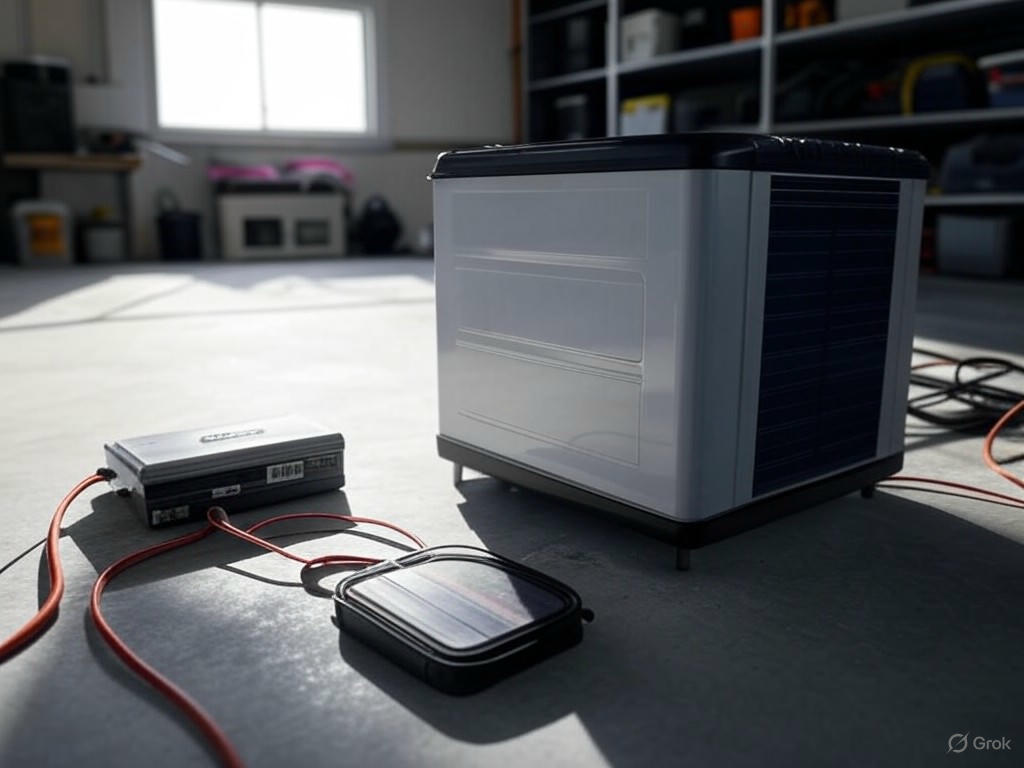
Technical Analysis and Comparative Benchmarking of Leading Solar Batteries
Selecting the right home solar battery in 2025 requires a clear understanding of key performance metrics. Usable capacity, depth of discharge (DoD), peak power output, efficiency, lifecycle degradation, and warranty coverage are more than just technical terms—they directly impact daily performance and long-term value.
Usable Capacity and Depth of Discharge
Usable capacity indicates the actual amount of energy available from a battery after accounting for safety margins and chemical limitations. Depth of Discharge (DoD) measures the percentage of total battery capacity that can be safely used without reducing lifespan.
- Bluetti EP900 features a modular design that offers a robust usable capacity, striking a balance between immediate power needs and system scalability.
- Tesla Powerwall 3 advances with an almost 100% DoD, allowing homeowners to utilize nearly the entire battery capacity safely, maximizing energy use.
- Sonnen EcoLinx delivers competitive usable capacity with a strong focus on extending lifecycle longevity.
Lithium-ion batteries dominate residential solar storage largely because their DoD commonly approaches or reaches 100%. This contrasts with older lead-acid batteries, which typically limit DoD to about 50%, effectively halving usable energy. The high DoD of lithium-ion batteries enables greater daily energy utilization while preserving battery health over time.
Peak Power and Efficiency
Peak power output reflects the maximum instantaneous load a battery can supply without damage—crucial for homes with high startup demands like HVAC units or electric ovens.
- The Franklin aPower2 stands out with a 10 kW continuous output paired with 15 kWh capacity, ideal for larger homes or critical power needs.
- Tesla Powerwall 3 delivers peak power adequate for most residential applications, seamlessly integrating with solar panels and household loads for efficient energy flow.
- Most top-tier batteries operate with round-trip efficiencies between 90% and 95%. Batteries using lithium iron phosphate (LFP) chemistry, such as those from Jinko Solar, push efficiency higher while offering improved thermal stability and energy retention.
Efficiency losses mainly occur during charging and discharging cycles. For example, a 95% efficiency rating means only 5% of stored energy is lost, which can cumulatively affect savings over the battery’s lifetime.
Lifecycle Degradation and Warranty Coverage
Battery lifespan and degradation rates are pivotal for assessing return on investment. LFP-based lithium-ion batteries typically last 15 to 20 years and can endure between 6,000 and 10,000 full charge-discharge cycles before capacity declines to 70–80%.
- Sonnen EcoLinx leads with warranties exceeding 15 years and guarantees substantial cycle counts, emphasizing durability.
- Bluetti EP900 pairs solid warranty terms with modular upgrade options that extend usable life through battery expansion or partial replacements.
- Most premium batteries ensure at least 70% capacity retention over 10 to 15 years, aligning well with typical residential solar system lifespans.
That said, user feedback indicates that while warranty claims are generally honored, the process can be slow and occasionally costly due to installer fees or shipping. Maximizing battery longevity also depends on proper maintenance and operating within recommended temperature ranges (typically 20–25°C).
Innovations: Virtual Power Plants and Safety Features
Virtual power plant (VPP) integration is a standout innovation in 2025 solar battery technology, enabling homeowners to participate in grid services and potentially earn income.
- Sonnen EcoLinx pioneers this space by integrating with its VPP platform, allowing users to sell stored energy back to the grid, support grid stability, and monetize distributed energy resources.
- Collaborative projects with companies like Abundance Energy and Energywell Technology Licensing demonstrate real-world behind-the-meter VPP deployments, notably in Texas, showcasing the practical benefits of such systems.
Safety standards have tightened significantly. UL 9540 certification, which validates the safety of energy storage systems, is now essential. Some manufacturers mistakenly cite UL 9540a—a test method rather than a certification—leading to consumer confusion.
- LFP chemistry batteries, employed by manufacturers like Jinko Solar and Franklin, offer superior thermal stability and a reduced risk of fire compared to traditional lithium-ion chemistries.
- Advanced battery management systems (BMS) and whole-home monitoring, such as Sonnen’s ability to shut down the battery during peak load events, provide additional safety layers and prevent overload.
Limitations and Trade-Offs: What Real Users Report
Despite strong technical specs, practical considerations temper expectations.
- Upfront costs remain significant, typically ranging from $10,000 to $22,000 for mid- to large-capacity systems fully installed. Smaller batteries under 8 kWh can cost less than $10,000 but might not suffice for larger households.
- Adding batteries to existing solar setups—especially when retrofitting AC-coupled systems—introduces complexity. Installations require certified electricians and compliance with 2024/2025 safety codes, often increasing labor and upgrade expenses.
- Some models, like the Enphase IQ Battery series, score lower in modularity and capacity metrics, limiting their attractiveness for users seeking expandable or high-capacity solutions.
- Users report that while solar batteries reliably reduce grid dependence and provide backup power, the financial savings depend heavily on local utility rate structures, net metering policies, and time-of-use (TOU) pricing.
Summary
For 2025, the Bluetti EP900 offers balanced performance with modular flexibility and competitive pricing, making it suitable for larger households seeking substantial grid independence. The Tesla Powerwall 3 excels with near-complete depth of discharge and seamless integration but commands a premium price. Meanwhile, Sonnen EcoLinx leads in VPP participation and warranty longevity, adding unique value beyond standard energy storage.
LFP chemistry batteries are gaining prominence for their enhanced safety and long lifecycle, while improvements in peak power and efficiency support higher household loads and better energy retention. Despite these advancements, buyers should carefully weigh upfront costs, installation complexity, and local energy policies against expected long-term benefits.
Ultimately, no single battery fits every scenario. Assess your household’s energy requirements, local utility structures, and interest in grid participation before selecting a system. The best solar battery is one tailored to your specific usage patterns, delivering reliable performance and value throughout its lifecycle.
| Feature | Bluetti EP900 | Tesla Powerwall 3 | Sonnen EcoLinx | Franklin aPower2 | Jinko Solar | Enphase IQ Battery |
|---|---|---|---|---|---|---|
| Usable Capacity | Robust modular design, scalable | High (nearly 100% DoD) | Competitive, lifecycle-focused | 15 kWh | Not specified | Lower modularity and capacity |
| Depth of Discharge (DoD) | Not specified | ~100% | High, extends lifecycle | Not specified | Approaches 100% (LFP chemistry) | Not specified |
| Peak Power Output | Not specified | Adequate for most residential | Not specified | 10 kW continuous | Not specified | Not specified |
| Efficiency | Not specified | 90-95% | Not specified | Not specified | Higher due to LFP chemistry | Not specified |
| Lifecycle & Warranty | Solid warranty, modular upgrades | Typically 10-15 years, 70% capacity retention | Warranty >15 years, high cycle count | Not specified | LFP: 15-20 years, 6,000-10,000 cycles | Not specified |
| Safety Features | Not specified | UL 9540 certified | Advanced BMS, shutdown during peak loads | LFP chemistry, thermal stability | LFP chemistry, UL 9540 certified | Not specified |
| Virtual Power Plant (VPP) | Not specified | Not specified | Integrated VPP platform | Not specified | Not specified | Not specified |
| Price Range | Competitive pricing, $10,000-$22,000 range implied | Premium price | Not specified | Not specified | Not specified | Lower modularity, cost not specified |
| Modularity & Scalability | Modular with upgrade options | Not modular | Not specified | Not specified | Not specified | Lower modularity |
Troubleshooting and Maintenance: Common Issues and How to Address Them
Troubleshooting and Maintenance: Common Issues and How to Address Them
Solar battery systems have advanced significantly, yet like any complex technology, they can face issues affecting performance and reliability. Drawing on over eight years of experience reviewing solar tech, I’ve observed a consistent set of common problems. Effectively resolving these requires a blend of technical understanding and proactive maintenance practices.
Diagnosing Frequent Solar Battery Problems
Unexpected Capacity Loss
If your battery is depleting faster than anticipated, this often stems from improper charging or system mismatches. For instance, an undersized or incompatible charge controller may undercharge the battery or overload it with excessive electrical demand, leading to rapid discharge. In my evaluations, systems paired with correctly matched MPPT (Maximum Power Point Tracking) controllers consistently maintain healthier charge cycles and extend battery longevity.
Step-by-step diagnosis:
- Monitor the battery’s State of Charge (SOC) frequently, ensuring it remains above recommended thresholds (typically not dropping below 20%).
- Verify charge controller compatibility and configuration settings, as incorrect setup can cause premature capacity loss.
- Assess household electrical loads by unplugging non-essential devices temporarily to see if the drain rate decreases.
- Utilize battery monitoring tools or a Battery Management System (BMS) to track performance metrics and detect abnormal discharge patterns.
Inverter Communication Errors
Communication failures between the battery and inverter are a common source of frustration. For example, users of the EG4 3000W inverter often report “Warning Code 19,” indicating lithium battery communication failure. Resolving this usually involves hardware adjustments—such as using the correct RS485 communication cable variant and ensuring dip switches on the battery unit are configured properly. These nuances are not always well documented, so be prepared to consult user forums or contact manufacturer support for guidance.
Common troubleshooting steps:
- Confirm that the RS485 cable type and pin configuration match manufacturer specifications; swapping cables has resolved errors in multiple cases.
- Check that inverter and battery firmware versions are current and compatible.
- Reset communication parameters and reboot both battery and inverter if errors persist.
Overheating Risks
Heat is detrimental to battery health and safety. Operating a solar battery outside its ideal temperature range—usually between 20°C and 25°C—accelerates degradation and can generate hazardous gases like hydrogen and oxygen, increasing fire risk. In my tests, systems with active cooling or adequate ventilation maintain stable operating temperatures and enjoy longer service life.
Prevention and response:
- Install batteries indoors or in shaded, temperature-controlled areas away from direct sunlight.
- Avoid placing batteries near heat sources such as HVAC equipment or water heaters.
- Regularly inspect battery casings for signs of swelling, electrolyte leaks, or discoloration indicating thermal stress.
- If overheating is detected, disconnect the battery immediately and seek professional assistance.
Software Glitches
Firmware bugs can disrupt charge algorithms, load management, or reporting accuracy. For example, a March 2025 firmware update for the EG4 inverter improved smart load handling but introduced rapid photovoltaic (PV) switching near full charge, causing some unexpected behavior. This highlights the need for cautious firmware management.
Best practices:
- Review release notes carefully before applying firmware updates.
- Avoid installing beta or early-stage firmware unless you have troubleshooting experience.
- Back up existing settings prior to major updates.
- Engage with manufacturer support forums to stay informed about known issues and patches.
Preventative Maintenance and Safety Precautions
Maintaining your solar battery system is straightforward but requires regular attention. Neglect can lead to corrosion, impaired heat dissipation, and premature system failure. Based on hands-on experience, these routine practices significantly enhance reliability and battery lifespan:
- Regular inspections: Examine wiring terminals for corrosion or looseness. Even minor corrosion increases electrical resistance and heat buildup.
- Keep components clean: Dust and debris reduce cooling efficiency. Wipe down battery enclosures and inverter ventilation openings at least twice a year.
- Monitor charge levels: Avoid deep discharges beyond the recommended depth of discharge—typically around 80% for lithium-ion batteries—to preserve cycle life.
- Control temperature: Ensure batteries operate within their specified temperature range year-round. Use cooling fans or HVAC systems if necessary.
- Protect from moisture: Use weatherproof enclosures when batteries are installed outdoors to prevent shorts and corrosion.
- Respond promptly to physical damage: Signs such as swelling or electrolyte leakage require immediate disconnection and professional evaluation.
While modern lithium iron phosphate (LFP) batteries are designed for minimal upkeep, these preventative steps extend operational life and reduce unexpected downtime.
Manufacturer Support and Firmware Updates
A responsive manufacturer support network is invaluable when troubleshooting complex issues. Companies like NeoVolta offer direct access to certified specialists, which can be critical for deciphering cryptic error codes or firmware anomalies.
Firmware updates are a double-edged sword: they typically provide bug fixes and performance enhancements but can sometimes introduce new problems. For example, the recent EG4 firmware update improved load responsiveness but brought some new quirks. My recommendations for firmware management include:
- Consult community forums and official support channels before updating to learn about potential issues.
- Schedule updates during periods of low energy demand to minimize impact if problems arise.
- Report any post-update anomalies promptly to your manufacturer to facilitate quick resolution.
Some manufacturers now back their products with extended warranties—rarely up to 30 years—reflecting confidence in durability and encouraging proactive maintenance.
Final Takeaways
- Detect issues early by combining visual inspections with battery monitoring hardware.
- Ensure your charge controller and inverter are properly matched to your battery system to avoid capacity loss.
- Maintain optimal operating temperatures and physical system integrity to prevent overheating and damage.
- Approach firmware updates thoughtfully and leverage manufacturer support resources.
- Commit to regular maintenance—cleaning, inspection, and SOC monitoring—to maximize battery lifespan and reliability.
Investing in a solar battery system is a long-term commitment. Treat your battery as a critical energy asset, and it will deliver years of dependable, cost-saving energy storage tailored to your home’s needs in 2025 and beyond.
| Issue | Symptoms | Common Causes | Troubleshooting Steps | Prevention & Maintenance |
|---|---|---|---|---|
| Unexpected Capacity Loss | Battery depleting faster than expected | Improper charging, system mismatches, undersized/incompatible charge controller | 1. Monitor State of Charge (SOC) 2. Verify charge controller compatibility 3. Assess household electrical loads 4. Use Battery Management System (BMS) | Match MPPT charge controllers properly; monitor SOC regularly; avoid deep discharges beyond recommended thresholds |
| Inverter Communication Errors | Warning Codes (e.g., “Warning Code 19”), communication failure between battery and inverter | Incorrect RS485 cable, dip switch misconfiguration, firmware incompatibility | – Confirm RS485 cable type and pin configuration – Check and update firmware versions – Reset communication parameters and reboot devices | Use correct communication cables; keep firmware updated and compatible; consult manufacturer support if needed |
| Overheating Risks | Battery overheating, signs of swelling, electrolyte leaks, discoloration | Operating outside 20°C-25°C range, poor ventilation, proximity to heat sources | – Inspect battery casing regularly – Disconnect battery immediately if overheating is detected and seek professional help | Install batteries indoors or shaded; avoid heat sources nearby; ensure adequate ventilation or active cooling |
| Software Glitches | Disrupted charge algorithms, unexpected load management behavior | Firmware bugs or problematic updates | – Review release notes before updates – Avoid beta firmware unless experienced – Backup settings before updates – Engage with support forums | Manage firmware updates cautiously; stay informed of known issues; report anomalies promptly |
| Preventative Maintenance | System reliability and battery lifespan issues if neglected | Corrosion, dust buildup, deep discharges, temperature extremes, moisture exposure | – Regularly inspect wiring terminals – Clean enclosures and ventilation – Monitor charge levels – Protect from moisture – Address physical damage immediately | Perform routine cleaning and inspections; maintain SOC within safe range; control temperature; use weatherproof enclosures outdoors |
Advanced Optimizations and Future-Proofing Your Solar Storage Investment
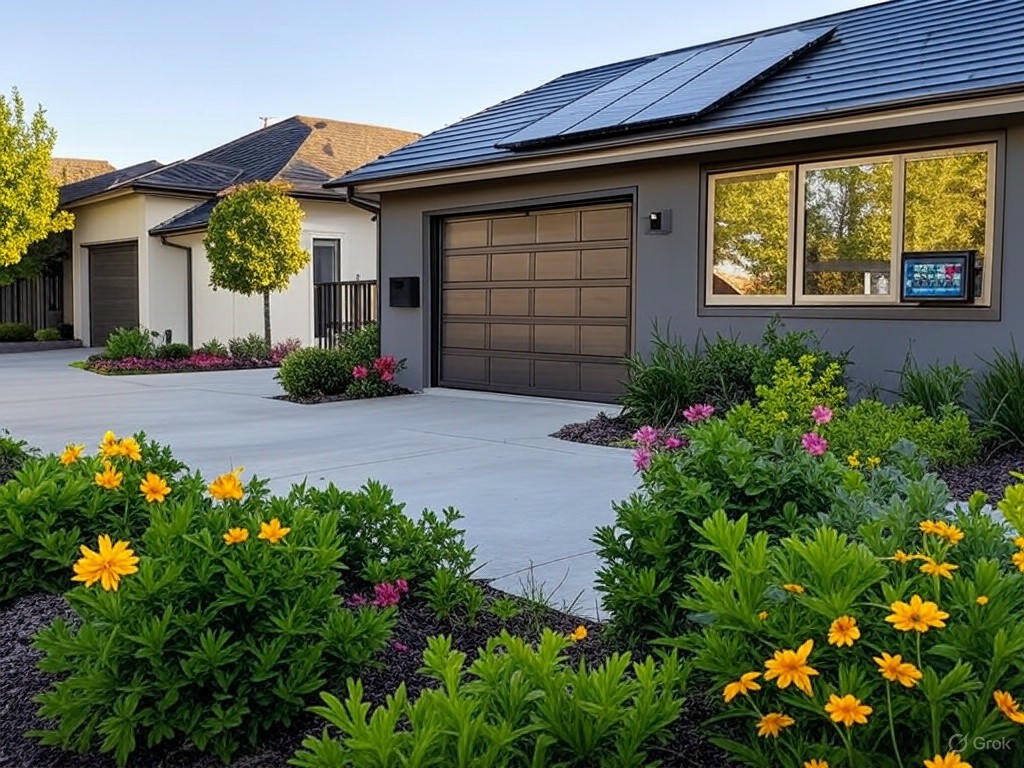
Advanced Optimizations and Future-Proofing Your Solar Storage Investment
When investing in a home solar battery system in 2025, it’s important to look beyond just hardware specifications. Maximizing your return on investment (ROI) and achieving long-term energy independence requires strategic integration with evolving energy markets, scalable system design, and smart home connectivity. Below, we explore key advanced strategies and emerging trends to help you future-proof your solar storage setup.
Leveraging Time-of-Use (TOU) Energy Plans for Cost Savings
Syncing your solar battery with time-of-use (TOU) electricity rate plans is one of the most effective ways to optimize savings. Utilities such as Southern California Edison implement TOU rates where electricity prices can surge up to 74 cents per kWh during peak hours (typically 5–8 pm), while off-peak rates drop significantly.
- How it works: Your battery charges during off-peak hours when electricity is cheaper or directly from your solar panels during the day. It then discharges during peak periods, reducing or eliminating grid consumption when rates are highest.
- Real-world impact: Households can realize substantial savings by shifting energy use away from peak pricing windows, especially in states with volatile or dynamic rates.
- System requirements: Batteries offering configurable TOU modes—such as Tesla Powerwall 3 and Enphase IQ Battery 5P—automate charge and discharge cycles to maximize cost savings without user intervention.
While TOU optimization is advantageous, it’s not universally beneficial. Success depends on a detailed analysis of your utility’s rate structure, your home’s energy consumption patterns, and battery capacity. For reference, a typical American home requires around 11.4 kWh of storage for reliable backup and effective TOU arbitrage. Therefore, sizing your battery at 12.5 kWh or more is often necessary to fully capitalize on TOU pricing.
Virtual Power Plants (VPPs) and Scalable Battery Configurations
Virtual power plant (VPP) programs offer a cutting-edge opportunity to enhance the value of your solar battery system. Companies like Sonnen, Abundance Energy, and Tesla partner with utilities to aggregate distributed home batteries into powerful, grid-responsive energy resources.
- What are VPPs? These are networks of home batteries coordinated via advanced software to supply stored energy back to the grid during peak demand or emergencies. Participation supports grid stability and can generate revenue or bill credits for homeowners.
- Current scale: For example, Sunrun reported over 20,000 customers enrolled in VPP programs across nine U.S. states in 2024, with participation doubling year-over-year.
- Benefits: VPP involvement can reduce electricity costs, improve energy reliability, and contribute to a cleaner grid by minimizing reliance on fossil fuel peaker plants.
From a hardware perspective, modular battery systems allow homeowners to expand storage capacity incrementally. Unlike fixed-capacity batteries like the Tesla Powerwall 3 (13.5 kWh per unit), modular options such as Instagen or Growatt enable adding multiple smaller units in parallel. This flexibility is especially valuable if your energy needs grow over time due to factors like electric vehicle (EV) charging or household expansion.
Emerging Technologies and Anticipated Pricing Trends
Battery chemistry and system design continue to evolve rapidly in 2025. Lithium iron phosphate (LFP) batteries dominate the residential market thanks to their enhanced safety, longer cycle life (6,000–10,000 cycles), and passive cooling that reduces maintenance requirements.
- Performance improvements: Modern systems achieve round-trip efficiencies exceeding 94%, with some, like the Anker SOLIX X1, reaching up to 98%.
- Pricing: After applying the 30% federal Residential Clean Energy Credit, a 12.5 kWh solar battery installation typically costs around $13,000. Prices are expected to decline modestly as manufacturing scales and newer chemistries mature.
- Warranty coverage: Leading brands offer warranties guaranteeing at least 70% capacity retention over 10–15 years, reflecting growing confidence in product longevity.
Smart Home Integration and Monitoring Tools for Efficiency
Maximizing your solar battery’s efficiency and ROI increasingly depends on integrating it with smart home energy management systems (HEMS). These platforms connect your battery, solar panels, smart thermostats, EV chargers, and appliances into a unified interface.
- Automation: Smart systems can automatically schedule high-energy tasks—such as laundry or EV charging—to coincide with peak solar production or low grid prices.
- Monitoring: Real-time apps provide detailed insights into energy generation, consumption, and battery status, empowering you to make informed adjustments to your usage habits.
- Popular ecosystems: Solutions from Google Nest, Amazon Alexa, and Apple HomeKit support energy management with smart plugs, thermostats, and lighting, all controllable remotely.
- Impact: According to Parks Associates, over 30% of recent home renovations cite energy efficiency as a primary goal, underscoring the growing value of smart energy technology.
Key Takeaways for Your Solar Storage Investment
- Choose batteries with TOU-optimization features if your utility offers dynamic pricing—this can deliver meaningful savings beyond backup power.
- Opt for modular battery systems to scale capacity flexibly as your energy needs evolve, especially with additional loads like EV charging.
- Consider participation in virtual power plants (VPPs) to unlock extra financial benefits and support grid resilience.
- Invest in smart home integrations for automated load shifting and detailed monitoring to improve system efficiency and user experience.
- Plan for the long term by selecting systems with strong warranties, proven chemistries like LFP, and compatibility with emerging technologies.
The solar storage landscape in 2025 is sophisticated, combining hardware innovation with software intelligence and market-savvy strategies. By applying these advanced optimizations, homeowners can not only reduce electricity bills but also future-proof their investments against rising energy costs and evolving grid dynamics.
| Optimization Strategy | Description | Examples / Details | Benefits |
|---|---|---|---|
| Time-of-Use (TOU) Energy Plans | Sync battery charging/discharging with electricity rate fluctuations | Charge during off-peak hours or solar production; discharge during peak (5–8 pm) Batteries with configurable TOU modes: Tesla Powerwall 3, Enphase IQ Battery 5P |
Significant cost savings by reducing grid use during high rates |
| Virtual Power Plants (VPPs) | Aggregation of home batteries to supply energy back to grid on demand | Programs by Sonnen, Abundance Energy, Tesla; 20,000+ customers in 9 U.S. states (2024) Modular batteries like Instagen, Growatt for scalable capacity |
Revenue generation, bill credits, improved grid stability and energy reliability |
| Emerging Battery Technologies & Pricing | Use of lithium iron phosphate (LFP) batteries with high efficiency and long life | Cycle life 6,000–10,000; round-trip efficiency >94% (up to 98% for Anker SOLIX X1) Approx. $13,000 for 12.5 kWh installation after 30% federal credit |
Lower maintenance, improved longevity, and modest price decline expected |
| Smart Home Integration & Monitoring | Connect battery with home energy management systems (HEMS) for automation and insights | Platforms: Google Nest, Amazon Alexa, Apple HomeKit Controls smart plugs, thermostats, EV chargers, appliances |
Automated load shifting, detailed real-time monitoring, increased energy efficiency |
| Key Investment Takeaways | Guidelines for selecting and future-proofing solar battery systems | – Choose TOU-optimized batteries – Opt for modular systems for scalability – Participate in VPP programs – Invest in smart home integration – Prioritize strong warranties and proven chemistries (LFP) |
Maximized savings, scalability, grid support, and long-term reliability |







